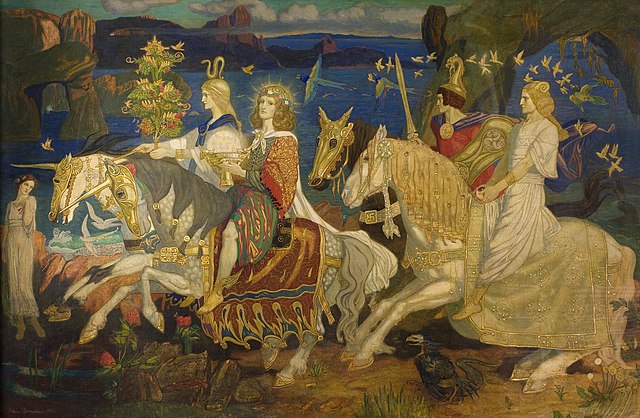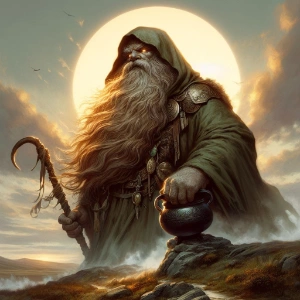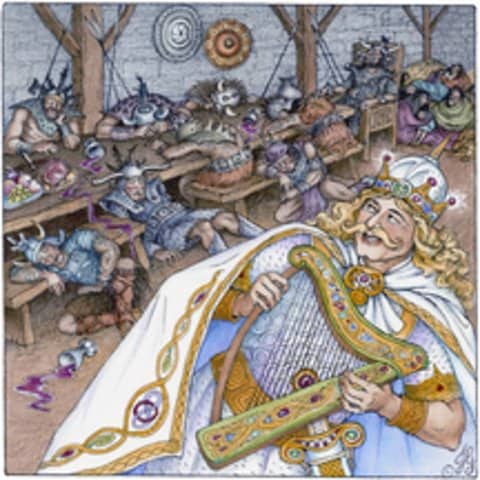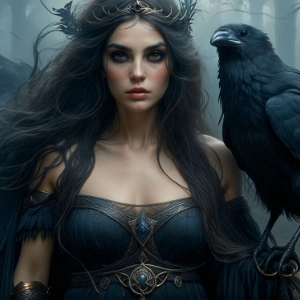The Dagda Chief of the Tuatha Dé Danann
Few figures are as fascinating and influential as the Dagda in the rich tapestry of Irish mythology. Often referred to as “The Good God” or “The Great God,” the Dagda holds a central place in the pantheon of the Tuatha Dé Danann, the ancient deities of Ireland. Known for his formidable powers and profound wisdom, the Dagda symbolises abundance, strength, and leadership.
In this blog post, we’ll embark on a journey into the world of the Dagda to unravel his essence, his representation, and the reasons behind his enduring allure. Whether you’re a novice in Irish mythology or seeking to enrich your knowledge, this guide will familiarise you with the critical aspects of the Dagda’s character and his profound influence on the myths that have shaped Irish culture.
Let’s examine this extraordinary deity’s legacy and understand why he remains a timeless figure in Irish narratives and customs.
Table of Contents
Who is the Dagda?

The Name “Dagda”
The name “Dagda” is derived from the Old Irish word “dag,” which means “good” or “great.” So, when we say “Dagda,” we’re referring to “The Good God” or “The Great God.” This title reflects his significant role and high status among the deities of Irish mythology. His name alone hints at his power and importance in these ancient stories.
Title: “The Good God” or “The Great God”
The Dagda is often called “The Good God” or “The Great God,” highlighting his revered position in the pantheon of the Tuatha Dé Danann. This title refers to his moral character as well as his impressive abilities and influence. As one of the chief deities, the Dagda embodies strength, wisdom, and generosity. His role is central to many myths, depicting him as a powerful and benevolent leader.
Role and Influence as Chief of the Tuatha Dé Danann
As the Tuatha Dé Danann chief, the Dagda leads the group of Irish gods and goddesses considered the ancient deities of Ireland. The Tuatha Dé Danann are known for their magical powers and deep connection to the land and its cycles. As their leader, the Dagda is a crucial figure in these myths, guiding and protecting his people through various challenges.
Associations with Fertility, Agriculture, and the Seasons
The Dagda is closely linked to fertility, agriculture, and the changing seasons. His association with fertility highlights his role in ensuring the land is productive, and crops grow plentifully. This connection extends to agriculture, where he is seen as a guardian of the earth’s abundance. His influence over the seasons also reflects his power to control the natural world and its cycles, ensuring balance and prosperity throughout the year.
In summary, the Dagda is a central figure in Irish mythology whose name, titles, and roles all emphasise his importance as a powerful and benevolent deity. His leadership among the Tuatha Dé Danann and his associations with fertility and the seasons make him a vital part of the mythological landscape.
The Dagda’s Attributes

Physical Appearance
The Dagda is often depicted as a large, hearty man with a robust and pleasant demeanour. His physical presence reflects his powerful and influential nature. He’s usually shown with a big belly and a friendly face, symbolising his abundance and generosity. This image of the Dagda highlights his strength and role as a provider and protector.
Common Depictions in Art and Literature
The Dagda is commonly represented in art and literature with three key symbols: his cauldron, club, and harp. These symbols illustrate his importance and the various powers he holds. Artists and writers often portray him as a strong and wise figure, emphasising his leadership among the Tuatha Dé Danann and his deep connection to the land and its cycles.
The Dagda’s Key Symbols
The Dagda’s Cauldron of Abundance
One of the most famous symbols of the Dagda is his Cauldron of Abundance. This magical cauldron is said to be never empty, always providing a bountiful supply of food and drink to those in need. Its significance lies in its role as a symbol of prosperity and nourishment. The cauldron represents the Dagda’s ability to ensure that his people are well-fed and cared for, reflecting his role as a benevolent leader who guarantees abundance.
The Dagda’s Club
Another important symbol is the Dagda’s club or staff. This club has a dual nature: one end can kill nine men with a single blow, while the other can bring them back to life. This magical ability illustrates the Dagda’s power over life and death, showcasing his role as a god who can protect and restore. The club’s dual nature highlights his balance of strength and compassion.
The Dagda’s Harp

The Dagda’s harp, known as the “Cláirseach,” symbolises his influence over music and the changing seasons. The harp’s music has the power to control the weather and affect people’s emotions, making it a vital tool for maintaining harmony and balance. Through his harp, the Dagda can usher in different seasons, reflecting his deep connection to the cycles of nature and his ability to bring about change.
Mythological Stories Involving the Dagda
The Cattle Raid of Cooley (Táin Bó Cúailnge)
The Dagda plays a supportive yet significant role in the epic tale known as the Cattle Raid of Cooley, an outstanding Irish Folk tale. This ancient story revolves around a great cattle raid between the armies of Connacht and Ulster. The Dagda, as a powerful god and leader of the Tuatha Dé Danann, aids his people with his magical abilities. Though he isn’t the central character in this tale, his presence and influence help shape the events and support the other gods and heroes involved in the conflict.
The Battle of Mag Tuired
The Dagda’s involvement in the Battle of Mag Tuired is much more prominent. This battle is a crucial event in Irish mythology where the Tuatha Dé Danann fought against the Fomorians, a group of chaotic and hostile beings. The Dagda is a crucial figure in this battle, using his formidable powers to help secure victory for his people. His leadership and magical abilities, including his powerful club and the Cauldron of Abundance, are vital in overcoming the Fomorians and establishing the Tuatha Dé Danann’s dominance in Ireland.
The Dagda and the Morrígan

The relationship between the Dagda and the Morrígan, the goddess of war and fate, is one of Irish mythology’s more complex and intriguing aspects. The Morrígan is known for her prophetic and often ominous nature, while the Dagda represents strength and wisdom. In some myths, the Morrígan appears to the Dagda in various forms, offering prophecies and guidance.
Their interactions often reflect themes of power, fate, and the balance between life and death. This relationship highlights Dagda’s role as a leader and warrior and as a figure deeply connected to the mystical and prophetic aspects of the mythological world.
The Dagda’s Influence on Irish Folklore
The Dagda has left a lasting mark on Irish folklore. He remains remembered as a powerful and influential figure in Irish culture. His influence can be seen in various aspects of folklore and tradition, reflecting his importance in the mythological landscape.
Influence on Irish Folklore
In Irish folklore, the Dagda is often celebrated as a benevolent and mighty deity. Stories and legends about him emphasise his strength, wisdom, and generosity. His magical symbols—like the Cauldron of Abundance, the Club, and the Harp—are frequently referenced in tales that highlight his connection to prosperity, balance, and the natural world. These symbols are mythical artefacts and represent ideals of abundance and harmony that resonate throughout Irish storytelling.
Remembered as a God
The Dagda is remembered as more than just a god of strength; he is also seen as a symbol of leadership and nurturing. His role as the chief of the Tuatha Dé Danann makes him a key figure in understanding ancient Irish beliefs about gods and their interactions with the world. In folklore, he is often depicted as a wise and caring figure who ensures that the land is fertile and that his people are well cared for.
His stories and attributes have inspired various cultural expressions, from literature and art to modern reinterpretations of Irish mythology. The Dagda’s legacy endures because he embodies the values of leadership, wisdom, and generosity. These qualities continue to be celebrated in contemporary Irish mythology and heritage discussions.
Recommended Books
Pagan Portals – the Dagda by Morgan Daimler
